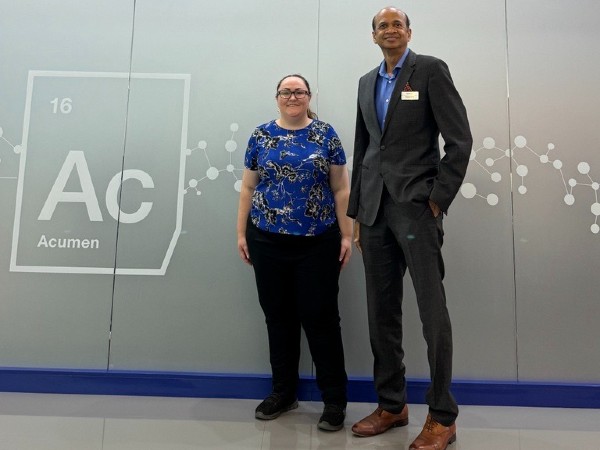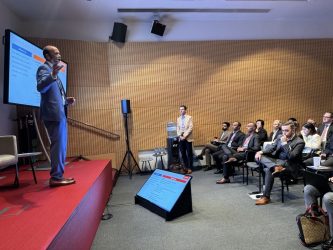Drug development trends: insight from Thermo Fisher’s Anil Kane
Posted: 1 December 2023 | Caroline Peachey (European Pharmaceutical Review) | No comments yet
In this interview, Anil Kane, Executive Director and Global Head of Technical & Scientific Affairs, Pharma Services, at Thermo Fisher Scientific discusses innovations in oral delivery of biologics, the rising popularity of prefilled syringes as well as global pharma trends in regulation and manufacturing.


During CPHI Barcelona, EPR Editor Caroline Peachey asked Anil Kane, Global Head of Technical & Scientific Affairs, Pharma Services, at Thermo Fisher Scientific about the dynamic landscape of pharmaceutical drug development.
Dr Kane leads a team of subject matter experts at Thermo Fisher, covering drug products in both sterile injectable dosage and oral solid dosage forms. This interview explores the innovations in biologics delivery, as well as the emergence of new modalities and the shift to continuous manufacturing.
What are the trends affecting drug development today?
Small molecules continue to be of interest going into oral solid dosage forms”
AK: That’s a very interesting question that can be addressed in a few different ways. From a drug development perspective, one of the trends is that small molecules continue to be of interest going into oral solid dosage forms. This is also evident from the number of US Food and Drug Administration (FDA) approvals and European Medicines Agency (EMA) approvals, which still show a large number of approvals on the small molecule side. However, we have also seen the growth of biologics and large molecules; for obvious reasons they go into sterile injectable dosage forms.
There is definitely an interest in advanced therapies, such as cell and gene therapy, plasmids, mRNA, and viral vectors. We are certainly seeing requests or demands for large molecules to be explored for oral delivery. So, large molecules such as proteins, peptides, oligonucleotides and enzymes have been evaluated in clinical trials for a variety of different indications. They could be for the oncology space, including different types of cancers, central nervous system indications such as Alzheimer’s, Parkinson’s and epilepsies, and also the most common indications for diabetes and other metabolic disorders. So that’s a new trend we’re starting to see – many companies exploring the application of large molecules that were traditionally administered via injectables for oral delivery instead.
What are some of the challenges with oral delivery of biologics and how are they being addressed?
AK: Traditionally, the reason for large molecules being delivered through an injectable route is due to the nature of the molecules themselves. For example, proteins, peptides and large biologics become unstable, from a chemical standpoint, as soon as they hit the low pH of the stomach. They were therefore administered through an injectable route or parenteral route for faster delivery and to bypasses the gastric stomach pH, to avoid deactivation or denaturation of proteins.
Most of these molecules in the large molecule category have no issues with solubility – in fact, they are highly soluble, but the problem has been the fact they are not permeable. So, because of the large molecule size, the difficulty was with absorption through the oral delivery system.
The major benefit of the oral delivery format is that it is more patient friendly”
With the newer technologies, excipients and materials that are being explored, it is now feasible to try [oral delivery of biologics] out. For all the indications mentioned earlier, there is certainly a higher probability of absorption success than what we have seen before.
So, even if the permeability and bioavailability is for example, 1.5x or 2x, that is definitely seen as a success and [worth] being explored through an oral route. The major benefit of the oral delivery format is its patient-friendly nature and that’s where the patient-centric drug product development is – it is the direction in which everybody in the field wants to go.
Going back to the sterile injectables space, could you talk a bit about prefilled syringes and what’s happening there?


Prefilled syringes bring a range of benefits.
AK: Prefilled syringes are definitely more patient friendly, as patients can take them home and self-administer without needing a physician or a pharmacist. This is one of the major reasons why pre-filled syringes are being sought, wherever applicable, for different molecules to be administered through an injectable sterile route.
Again, irrespective of the indication, whether it’s for oncology or for diabetes, the device itself is getting popular because it enables sterile manufacturing possibility, dosage accuracy, and a variety of other benefits that prefilled syringes bring from an administration and patient-centric perspective.
What are the main regulatory challenges or upcoming challenges that you see impacting the industry?
We are increasingly seeing the focus move to globally approvable drug substances or drug products”
AK: I wouldn’t say ‘challenges’, but certainly trends. As Thermo Fisher supports its global partners, there are more and more requirements for global regulatory approval. So whether it’s a small molecule, large molecule and/or an advanced therapy, partners are wanting to develop globally approvable products. Ten or 20 years ago, the focus was to begin with a certain region, maybe a European approval, or a US FDA approval, and then expand the territories to other regulatory approvals and other parts of the world. I think we are increasingly seeing the focus move to globally approvable drug substances or drug products. This saves time and additional work that may be required from a regulatory perspective — to have different timelines for products to be introduced, filed and approved into the global markets.
Given that regulations differ regionally, how do you address that?


Companies are increasingly taking a global approach to drug development.
AK: I think having a global presence with manufacturing capabilities in different regions, and understanding the nuances or differences, as you mentioned, between the regulatory expectations of different agencies will be an advantage.
We want to develop a quality-compliant product that is approvable in the first instance because these days, more than ever before, there is timeline pressure from development, going through clinical phases and developing an approvable product for different markets. So, the knowledge, the experience of handling and addressing the different requirements from a global regulatory perspective, is key to bringing products into filing and approval.
Looking ahead, what do you see as a significant innovation that will impact the industry in the next three to five years?
By using different modalities…the pharma industry is wanting to cater to the newer medical needs to bring effective medications to patients”
AK: There are several areas, in general, that the pharma industry is looking at or exploring to invest in. We talked about different modalities, like advanced therapies and at the application of existing technologies in different indications. There are certainly, in the area of niche indications, breakthrough therapy designations and fast-track approvals for different types of cancers and certain types of immunologic conditions where the patient population is not very large, globally. But how do we adapt everything from the development, clinical and manufacturing perspective for these niche indications to address unmet medical needs of the patient population? So again, focusing on small-scale, commercial manufacturing for niche indications, having fast track approval and getting the therapies to patients faster; these are certainly areas that the pharma industry is exploring. By using different modalities, we’re not focusing on certain types of drug delivery systems (like oral solids, injectables or advanced therapies). Rather, the pharma industry is wanting to cater to the newer medical needs to bring effective medications to patients.
What kind of technologies might we see over the coming years?
I think we’ll see more applications of continuous processing, continuous manufacturing”
AK: From a technology perspective, first, I think we’ll see more applications of continuous processing, continuous manufacturing, whether it’s drug substance or drug product. Also, we can expect to see the utilisation of digital technologies for predictive modelling. For example, in selecting the best technology, we can obtain and use data-based analytics to design scale of tech transfer, to make scientific, data-based process improvements, and to bring efficiencies in process. So, application of those techniques and technologies and bringing process cost efficiencies are going to be beneficial for the pharma industry.
In terms of continuous manufacturing and digitalisation, can you share where Thermo Fisher is at in these areas?


Anil Kane spoke at CPHI Barcelona about how CDMOs are evolving to meet drug development needs
AK: As I presented in my talk recently, we have already invested into continuous flow chemistry for active pharmaceutical ingredient (API) manufacturing for certain critical reactions from an API synthetic small molecule perspective.
Similarly, on the drug product side, we have invested in continuous drug product manufacturing to bring cost efficiencies on certain candidates of our products. So certainly, as applicable, we are supporting our partners with moving into these types of continuous processes.
What has been your highlight for 2023?
AK: I think this has been a fairly good year, coming out of the pandemic. The pandemic has taught the whole world a lot. The positive thing we have learned lessons from that experience, including how to adapt and have flexibility in our approach. This applies to drug development from a clinical perspective as well as adapting to commercial manufacturing needs; these are certainly areas that we and the entire industry have learned to focus on as a result of the pandemic.
About the interviewee
Anil Kane, PhD, MBA, is Global Head of Technical & Scientific Affairs, Pharma Services, Thermo Fisher Scientific. Dr Kane has more than 25 years of experience in the science and business of taking molecules through the entire drug development process, spanning early-stage development to scale-up and commercial manufacturing. His experience includes technical transfers between global sites and drug life cycle management.
He was a speaker at CPHI Barcelona, which took place from 24-26 October 2023.
Related topics
Active Pharmaceutical Ingredient (API), Biologics, Biopharmaceuticals, Drug Delivery Systems, Drug Development, Drug Manufacturing, Manufacturing








